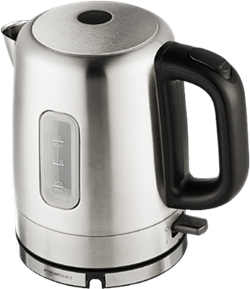Contents
- 1. What’s the total capacity of the kettle?
- 2. How long does it take to boil the water?
- Stans Tips Saving For Electric Kettle [Today Deals]
- 3. Is there a keep-warm option?
- 4. Is there an auto-shutoff or boil dry protection?
- 5. Is the base cordless (or is the cord detachable) for easy serving?
- 6. Is the spout non-spill?
- 7. What’s the minimum amount of water you can boil?
- 8. Is there a temperature selection feature?
- 9. Is the handle comfortable? Is it non-slip? Does it get hot?
- 10. Is the heating element immersed or hidden?
1. What’s the total capacity of the kettle?

Electric kettles on the market have different capacities ranging from 1 liter to 2 liters. Most kettles will be around the 1.5-liter mark, which is enough for most people. If you are going to boil water for 1 or 2 cups of tea or coffee, even a 1-liter model will do. However, if you need to boil water to serve a couple of friends, or to prepare soup, etc. for 3-4 people, a bigger capacity model will be more convenient.
2. How long does it take to boil the water?
In addition to the capacity, consumers will also want to know how fast the kettle is. After all, the reason why people use kettles is to have hot water almost instantly. Most decent kettles will take only 3-4 minutes to boil the water; if it takes less, it’s better.
Hint: Some models are prone to scale build-up, which greatly reduces the boiling performance. If there are suggestions to minimize scale build-up, you may get the best out of the kettle.
Stans Tips Saving For Electric Kettle [Today Deals]
3. Is there a keep-warm option?
Another important and handy feature is the kettle’s ability to keep the water warm after the boiling is complete. Some models will be able to keep the water at the desired temperature for about 30 minutes – 1 hour, which is very convenient for the user. Some models even have a dedicated keep warm option, so that the user can choose when the use this feature.
4. Is there an auto-shutoff or boil dry protection?
This is a very important (and sometimes vital) safety feature. Some models claim to have this feature while in reality, it doesn’t work as intended. If this feature doesn’t work (or exist), there will be a big fire hazard if the user forgets to shut off the kettle for an extended period.
5. Is the base cordless (or is the cord detachable) for easy serving?
One of the things that annoy the users most is the cord getting in the way while they’re pouring water from the kettle. Hence, cordless models or the ones with detachable cords are preferred by most. In addition, most new models have a separate base, allowing the user to lift and carry the kettle away without being disturbed by the cord.
6. Is the spout non-spill?
Another annoyance is spilling water to the counter while pouring from the kettle. It can also be somewhat dangerous if the water spills near the base or cord or if hot water spills to the user’s hands, etc. Most decent models have non-spill spouts that provide safeguards against this annoyance/risk.
7. What’s the minimum amount of water you can boil?
Sometimes people don’t need to boil lots of water; they may be boiling water for just one cup of tea or coffee before they leave for work in the morning or for a soothing green tea before bed. If the kettle doesn’t allow users to boil one or two cups worth of water, some people may see it as a negative.
8. Is there a temperature selection feature?
Some advanced (and somewhat pricier) models have temperature selection features that allow users to boil the water to the desired degree (for instance, 175 degrees for green tea, 200 for herbal, etc.) While this is not a vital feature, it sure adds to the convenience and can appeal to some people.
9. Is the handle comfortable? Is it non-slip? Does it get hot?
The handle is an important part of the kettle, and it’s essential that it’s comfortable and non-slip. People will be serving/pouring boiled water and any slip or accident can have dramatic results. Most models nowadays have non-slip handles that are designed with ergonomics and a good grip in mind.
It’s also important to note whether or not the handle gets hot. If it gets hot, it can burn the user’s hand or cause them to spill water, leading to accidents and even injuries.
This one is important in terms of scale build-up. While there is no performance difference between the two models per se, hidden heating elements are known to cause less scale build-up. This will affect the long term performance of the kettle as the more scale will build up, the less efficient will the kettle be. Plus, scale build-up will add another inconvenience by forcing users to periodically clean the kettle and remove the scale.